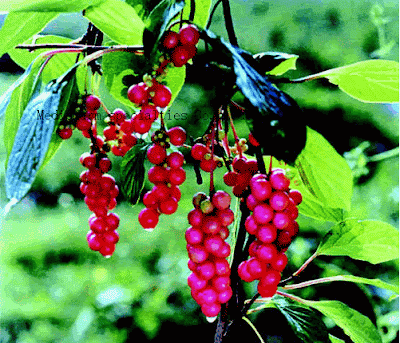Schisandra Chinensis is originated from northeastern China.
It is more known as "five flavor berry" which is also the literal meaning. It is a kind of deciduos woody vine native to forest of Northern China and The Russian Far East. The plants prefer some shades with moist and well-drained soil. The species itself is dioecious, thus flowers on a female plant will only produce fruit when fertilized with pollen from a male plant. Easter Prince is a hybrid selection which has perfect flowers and is self-fertile. Seedlings of Eastern Prince are sometimes sold under the same name but are typically single-sex plants.
Schisandra
Wednesday, June 5, 2013
How to Plant Schisandra
Schisandra Chinensis is a deciduous woody vine native which likes some shade with moist, well-drained soil. Cultivation requirements are thought to be similar to those of grapes. It is hardly to US Zone 4. Schisandra Chinensis requires conditions of moderate humidity and light, together with a wet, humus-rich soil. Tens of tons of berries are used annually in Russia in the Primorsky and Khabarovsky regions for the commercial manufacture of juices, wines, extracts and sweets.
Health Benefits of Schisandra
Schisandra Chinensis is can used as medicine. Its berries are used in traditional Chinese medicine where it is considered one of the 50 fundamentl herbs.
They are most often used in dried form and boiled to make a tea. Chemical constituents include the lignans schizandrin, deoxyschizandrin, gomisins, and pregomisin, which are found in the seeds of the fruit. It should not be used by pregnant women. You can make wine as well from the berries. In Korean the berries are known as omija. In Japanese, they are called gomishi. The Ainu people used this plant, called repnihat, as a remedy for colds and sea-sickness. The plant is believed to act as an astringent for the Qi of the lungs and kidneys, restrain the essence to treat diarrhea. arrest excessive sweating from deficiency of Yin or Yang, calm the spirit by refreshing the heart and kidneys, and generate body fluid and reduce thirst. In Russia it was used by Nanai hunters to improve night vision, as a tonic and to reduce hunger, thirst and exhaustion since "it gives forces to follow a sable all the day without food.
They are most often used in dried form and boiled to make a tea. Chemical constituents include the lignans schizandrin, deoxyschizandrin, gomisins, and pregomisin, which are found in the seeds of the fruit. It should not be used by pregnant women. You can make wine as well from the berries. In Korean the berries are known as omija. In Japanese, they are called gomishi. The Ainu people used this plant, called repnihat, as a remedy for colds and sea-sickness. The plant is believed to act as an astringent for the Qi of the lungs and kidneys, restrain the essence to treat diarrhea. arrest excessive sweating from deficiency of Yin or Yang, calm the spirit by refreshing the heart and kidneys, and generate body fluid and reduce thirst. In Russia it was used by Nanai hunters to improve night vision, as a tonic and to reduce hunger, thirst and exhaustion since "it gives forces to follow a sable all the day without food.
Uses of Schisandra
Schisandra Chinensis is a plant with many uses. The fruit is used as food and also to make medicine. It is used as an “adaptogen” for increasing resistance to disease and stress, increasing energy, and increasing physical performance and endurance.
It is also used for preventing early aging and increasing lifespan; normalizing blood sugar and blood pressure; and stimulating the immune system and speeding recovery after surgery. Schisandra is also used for treating liver disease (hepatitis) and protecting the liver from poisons. The Chinese have developed a liver-protecting drug called DBD that is made from schisandrin, one of the chemicals in schisandra.
Other uses for schisandra include treatment of high cholesterol, coughs, asthma,sleep problems (insomnia), nerve pain, premenstrual syndrome (PMS), chronic diarrhea, dysentery, night sweats, spontaneous sweating, involuntary discharge of semen, thirst, erectile dysfunction (ED), physical exhaustion, excessive urination,depression, irritability, and memory loss.
It is also used for preventing early aging and increasing lifespan; normalizing blood sugar and blood pressure; and stimulating the immune system and speeding recovery after surgery. Schisandra is also used for treating liver disease (hepatitis) and protecting the liver from poisons. The Chinese have developed a liver-protecting drug called DBD that is made from schisandrin, one of the chemicals in schisandra.
Other uses for schisandra include treatment of high cholesterol, coughs, asthma,sleep problems (insomnia), nerve pain, premenstrual syndrome (PMS), chronic diarrhea, dysentery, night sweats, spontaneous sweating, involuntary discharge of semen, thirst, erectile dysfunction (ED), physical exhaustion, excessive urination,depression, irritability, and memory loss.
Schisandra in Europe
Schisandra Chinensis is a very popular plants from China due to its more benefits inside and outside the body.
In Europe, the plants is popular as medicinal use as well as use for some beauty products. It contains a lot of nutrients and supplements that can maintain wellness to the body and cure some diseases at the same time. Europeans found it very useful plants for certain diseases such as diaphoresis or excessive sweating, memory loss, excessive urination and some lung problems. It can be use as wine or tea that can hydrate and helps to refresh and look younger. It is good for skin and different parts of the body.
In Europe, the plants is popular as medicinal use as well as use for some beauty products. It contains a lot of nutrients and supplements that can maintain wellness to the body and cure some diseases at the same time. Europeans found it very useful plants for certain diseases such as diaphoresis or excessive sweating, memory loss, excessive urination and some lung problems. It can be use as wine or tea that can hydrate and helps to refresh and look younger. It is good for skin and different parts of the body.
Subscribe to:
Posts (Atom)




